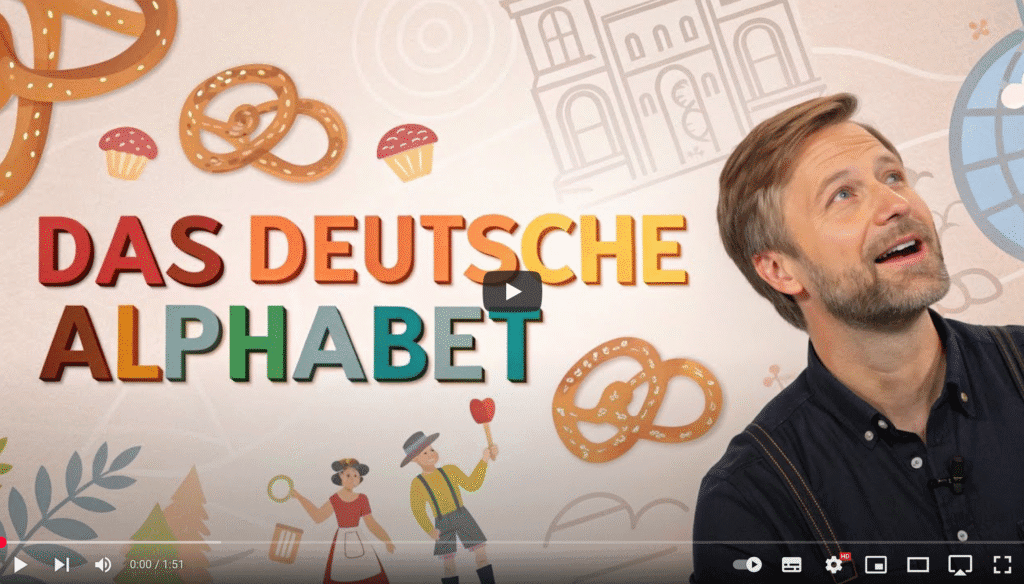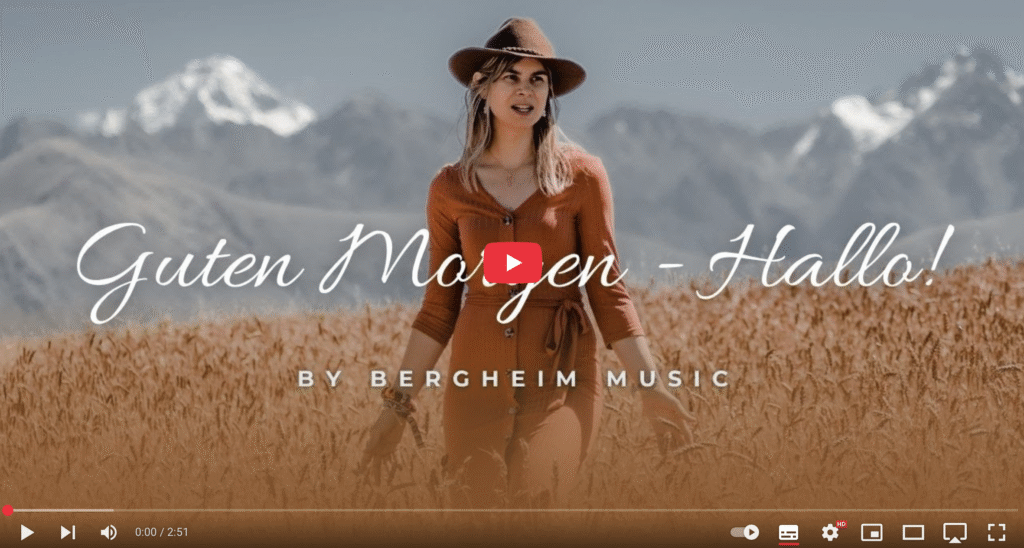Day 1: Alphabet, pronunciation, formal and informal greetings
Overview
Self-Study Topic | Duration: 25–30 minutes
Level: Absolute Beginner
OBJECTIVE
By the end of this topic, you will be able to:
✔ Recognize and pronounce German letters (including umlauts and ß).
✔ Distinguish between formal (Sie) and informal (du) greetings.
✔ Introduce yourself in both formal and informal settings.
CONTENT
1. WARM-up
Self-Reflection:
- Do you know any German words already? Think of movies, songs, or travel experiences.
- Write down some German words you are familiar with!
Tip: Don’t worry about spelling yet—jot down what comes to mind (e.g., “danke,” “Guten Tag”)

2. Learn the German Alphabet
PRACTICE Letters & Pronunciation
- Study the alphabet in the table below.
- Listen to the audio clip to hear each letter and word pronounced.
- You may pause the recording or rewind whenever necessary.
- Repeat the words. You will find additional pronunciation advice below the table.
- Alternatively, watch our YouTube video (link below the table).
Click here for advice on HOW TO PRACTICE
- Listen & Repeat: Play the audio, then say each letter and word aloud.
- Word Association: Cover the “Meaning” column and test yourself (e.g., “Buch = book”).
- Spelling Drill: Spell each word letter-by-letter (e.g., “A-P-F-E-L”).
- Tip: For tricky letters (Ä, Ö, Ü, ß), repeat the words slowly: Listen & Repeat: Play the audio, then say each letter and word aloud.
- Word Association: Cover the “Meaning” column and test yourself (e.g., “Buch = book”).
- Spelling Drill: Spell each word letter-by-letter (e.g., “A-P-F-E-L”).
- Tip: For tricky letters (Ä, Ö, Ü, ß), repeat the words slowly (e.g.“Übung: OO-bung”, pretend you’re blowing out a candle for the “Ü”).
| Letter | Pronunciation | Example Word | Meaning |
|---|---|---|---|
| A | ah | Apfel | apple |
| B | bay | Buch | book |
| C | tsay | Café | café |
| D | day | Dorf | village |
| E | ay | Eltern | parents |
| F | eff | Fenster | window |
| G | gay | Garten | garden |
| H | hah | Haus | house |
| I | ee | Iglu | igloo |
| J | yot | Jahr | year |
| K | kah | Kind | child |
| L | ell | Lampe | lamp |
| M | emm | Mutter | mother |
| N | enn | Name | name |
| O | oh | Ohr | ear |
| P | pay | Paar | pair |
| Q | koo | Quark | curd cheese |
| R | err | Rad | wheel |
| S | ess | Sonne | sun |
| T | tay | Tür | door |
| U | oo | Uhr | clock |
| V | fow | Vogel | bird |
| W | vay | Wasser | water |
| X | iks | Xylophon | xylophone |
| Y | ypsilohn | Yoga | yoga |
| Z | tset | Zug | train |
| Ä | ah-umlaut | Äpfel | apples |
| Ö | oh-umlaut | Öl | oil |
| Ü | oo-umlaut | Übung | exercise |
| ß | ess-tset | Straße | street |
Click here for PRONUNCIATION ADVICE
| Letter | Sound in English Terms | Example Word | Pronunciation Advice | Common Mistakes |
| y | “ü” (like French “u”) | Yoga | Purse your lips tightly as saying “ee” but say “oo” instead. Like saying “ew” in “few” but shorter. | Don’t pronounce like English “y” in “yes.” |
| z | “ts” (like “cats”) | Zug (train) | Start with a sharp “t” immediately followed by “s.” Like the “zz” in “pizza.” | Avoid English “z” (as in “zoo”). |
| ä | “eh” (like “air” without the ‘r’) | Äpfel (apples) | Say “ay” (as in “day”) but with mouth slightly more open. Similar to “e” in “bed.” | Don’t confuse with German “a” (ah). |
| ö | No exact English equivalent | Öl (oil) | Shape lips for “o” but try to say “eh.” Like “i” in “girl” (British pronunciation). | Avoid pronouncing like plain “o.” |
| ü | No exact English equivalent | Übung (exercise) | Shape lips for “oo” but try to say “ee.” Like blowing out a candle while saying “ee.” | Don’t substitute with English “oo.” |
| ß | “ss” (sharp “s”) | Straße (street) | Hiss like a snake—prolong the “s” sound. Always unvoiced (no vibration in throat). | Never pronounce like a “b” or “z.” |
Watch the Alphabet video, Listen and Repeat
2. PRONUNCIATION OF CONSONANT CLUSTERS AND DIPHTHONGS
PRACTICE:
- Study the table below.
- Listen to the audio clip to hear each cluster and word pronounced.
- You may pause the recording or rewind whenever necessary.
- Repeat the words.
Click here for advice on HOW TO PRACTICE THESE SOUNDS
- Listen & Mimic: Listen to the audio once. Then play the audio again, pause after each word, and repeat it 3x.
- Minimal Pairs: Contrast similar sounds:
- schon (already) vs. sonne (sun)
- Haus (house) vs. Häuser (houses)
- Tongue Twister Challenge:
- “Zehn Ziegen zogen zehn Zentner Zucker zum Zoo.”
- (Ten goats pulled ten hundredweight of sugar to the zoo.)
- Self-Check:
- Try saying Straße (street) with a sharp “ss” for ß.
- Can you hear the difference between ich (soft ch) and Bach (guttural ch)?
- Pro Tip: Record yourself and compare it to original audio.
A. CONSONANT CLUSTERS
| Sound | English Approximation | Example Word | Meaning | Pronunciation Tip |
|---|---|---|---|---|
| sch | “sh” in shoe | Schule | school | Round lips slightly. |
| sp | “shp” (initial) | Spiel | game | Blend “s” + “p” quickly. |
| st | “sht” (initial) | Stuhl | chair | Like sp but with “t”. |
| tsch | “ch” in chip | Tschüss! | bye (slang) | Sharp, short sound. |
| pf | “pf” (both letters) | Pfanne | pan | Press lips together first. |
| ch (after a, o, u) | “kh” (guttural) | Bach | brook | Like clearing your throat. |
| ch (after e, i, ä, ö, ü) | “hiss” (softer) | ich | I | Like a cat hissing. |
| ng | “ng” in sing | singen | to sing | Nasal sound. |
2. DIPHTHONGS (VOWEL COMBOS)
| Sound | English Approximation | Example Word | Meaning | Pronunciation Tip |
|---|---|---|---|---|
| ei | “eye” | Ei | egg | Say “a” + “ee” fast. |
| ai | “eye” | Main | river Main | Same as ei. |
| ie | “ee” in see | Brief | letter | Hold the “ee” sound. |
| au | “ow” in cow | Haus | house | Round lips at the end. |
| äu | “oy” in boy | Häuser | houses | Like au but higher pitch. |
| eu | “oy” in boy | neu | new | Same as äu. |

3. Formal vs. Informal Greetings
Practice
- Study the table below.
- Listen to the audio clip, pause, and repeat the phrases.
- Listen & Categorize: Play the audio clip again. Identify which phrases are formal/informal.
- Use your phone to record:
- A formal self-introduction (“Guten Tag, ich heiße [Name].”).
- An informal greeting to a friend (“Hallo! Wie geht’s?”).
key phrases
| Formal (Sie) | Informal (du) |
|---|---|
| Guten Morgen! / Guten Tag! / Guten Abend! (good morning / good day / good evening) | Hallo! / Hi! / Moin! (Northern Germany) (hi) |
| Wie heißen Sie? (What’s your name?) | Wie heißt du? (What is your name?) |
| Ich heiße (Name). (My name is …..) | Ich heiße (Name). (My name is …..) |
| Wie geht es Ihnen? (How do you do?) | Wie geht’s? (How are you?) |
| Es geht mir gut, danke! (I’m fine, thank you!) | Gut, danke! (Fine, thanks!) |
| Auf Wiedersehen! (goodbye) | Tschüss! / Ciao! (bye/bye-bye) |
4. Homework & Preview FOR TOMORROW
Homework
- Writing: Copy the alphabet once and write 3 formal + 3 informal greetings.
- Listening: Watch our song on greetings and sing along (link below).
- Speaking: Record yourself greeting in a formal and informal way.
PREVIEW
Tomorrow, we’ll learn numbers 1-100 and further self-introduction.
You’ve just taken your first step toward speaking German—celebrate that!
word of encouragement
And remember: mistakes are part of learning.


